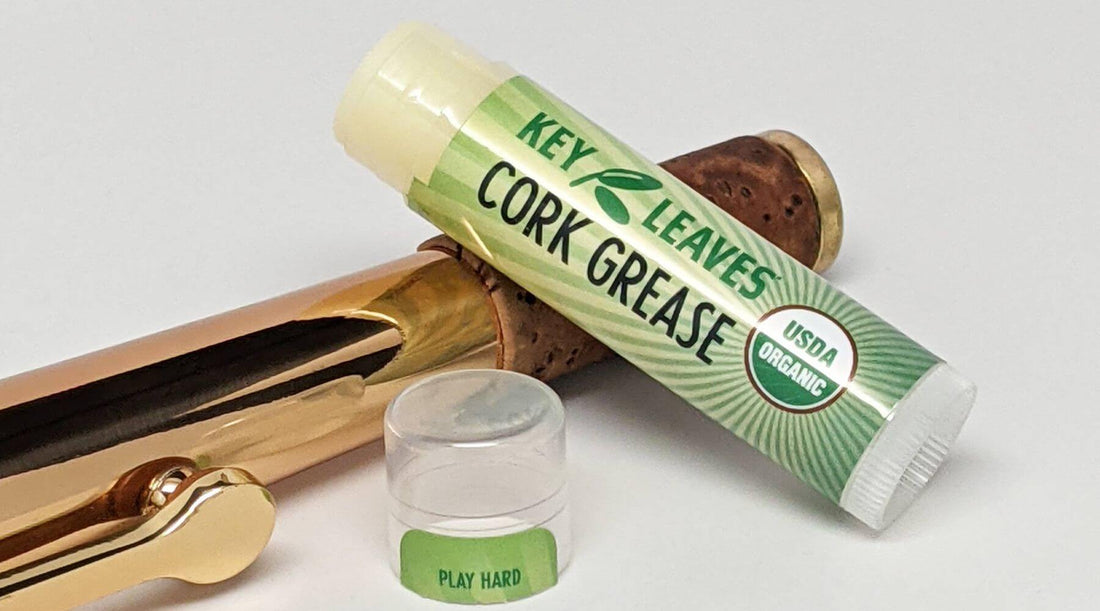
How to Use Cork Grease on a Saxophone
Share
Applying cork grease to the neck of the saxophone is a critical step in saxophone maintenance. This article details how to use cork grease, how often to do it, and more.
Skip to a Section:
How Do You Use Cork Grease on a Saxophone?
Where Do You Put Cork Grease on a Saxophone?
How Often Should You Put Cork Grease on a Saxophone?
Is There Such Thing as Using Too Much Cork Grease?
What Happens if You Don’t Use Saxophone Cork Grease?
Other Frequently Asked Questions
How Do You Use Cork Grease on a Saxophone?
To use saxophone cork grease (which typically looks like a chapstick tube), apply a light layer on the neck cork, then gently rub in the cork grease. Below, we’ll talk more about how to put cork grease on a saxophone, when to apply cork grease, and more.
Where Do You Put Cork Grease on a Saxophone?
On a saxophone, the cork grease goes on the cork on the neck, where the mouthpiece slides onto.

Check out this video below, showing you exactly how to apply cork grease (the video starts right at the cork grease how-to):
How Often Should You Put Cork Grease on a Saxophone?
You should put cork grease on a saxophone almost daily (or whenever you play), especially if the cork feels dry to the touch. If your cork is already very well moisturized, feel free to skip it for a few days.
Although not as delicious as a seasoned cast iron pan, the process of applying cork grease can be similar to seasoning a cast iron pan. It’s a little more work up front if the cork is new or wasn’t previously maintained well, but it becomes more hands-off once it’s in good shape.
Always check your cork before putting the mouthpiece on. If it feels dry to the touch, add a thin layer of cork grease. A tell-tale sign that your cork urgently needs cork grease is a squeaking sound when you put on the mouthpiece. If you hear any squeaking when placing the mouthpiece on the cork, STOP immediately. Slowly and gently twist off the mouthpiece and apply cork grease.
Is There Such Thing as Using Too Much Cork Grease?
Yes, you can use too much cork grease. Petroleum formulations in some cork grease brands can penetrate the cork and weaken the glue bond over time, potentially causing your cork to come off entirely. This is why our Key Leaves cork grease uses only premium, USDA organic ingredients that are proven safe on all finishes and cork adhesives.
It is also important to only use a thin layer of cork grease per application.
Is Cork Grease Necessary? What Happens if You Don’t Use Saxophone Cork Grease?
Cork grease is necessary for saxophones. If you don’t use cork grease on your saxophone neck, the cork can become dry and may crack, which means you won’t be able to put the mouthpiece on the saxophone and won’t be able to play. If your cork becomes cracked, it can leak air as you play and will, of course, need to be replaced by a professional repair tech.
Other Frequently Asked Questions About Saxophone Cork Grease
Is it okay to use chapstick as cork grease?
No! Do not use chapstick as cork grease. Even though cork grease tubes look like chapstick, they hold an entirely different product. The ingredients in chapstick are not cork-safe. Conversely, please don’t use cork grease as chapstick either! It won’t be a pleasant experience.
Can I use Vaseline for cork grease?
No, you should not use Vaseline for cork grease because it is a deep-penetrating petroleum product that can work through the cork and weaken the glue bond, causing the cork to come off the saxophone. Plus, Vaseline tends to stay very sticky on the cork, which can cause dust and dirt to stick to the sax cork, causing abrasive gunk to rub on your saxophone mouthpiece.
What is saxophone cork grease made of?
Most saxophone cork grease is made of readily available (lower cost) petroleum-based distillates or synthetic lubricants, which help keep cork soft and supple. However, some petroleum formulations can weaken the glue bond between the cork and the saxophone, causing the cork to come off the instrument.
Some "all-natural" cork greases use natural lubricants like beeswax or coconut oil, which are more expensive but often feel nicer and work as well or better than traditional cork grease.
Key Leaves is the first company to produce an FDA-certified organic cork grease made from natural lubricants, including organic sunflower oil and organic beeswax, avoiding petroleum-based ingredients altogether.
That’s it! You now have all the know-how around using cork grease on a saxophone. You’re all set to keep your saxophone neck cork healthy for a long time!
